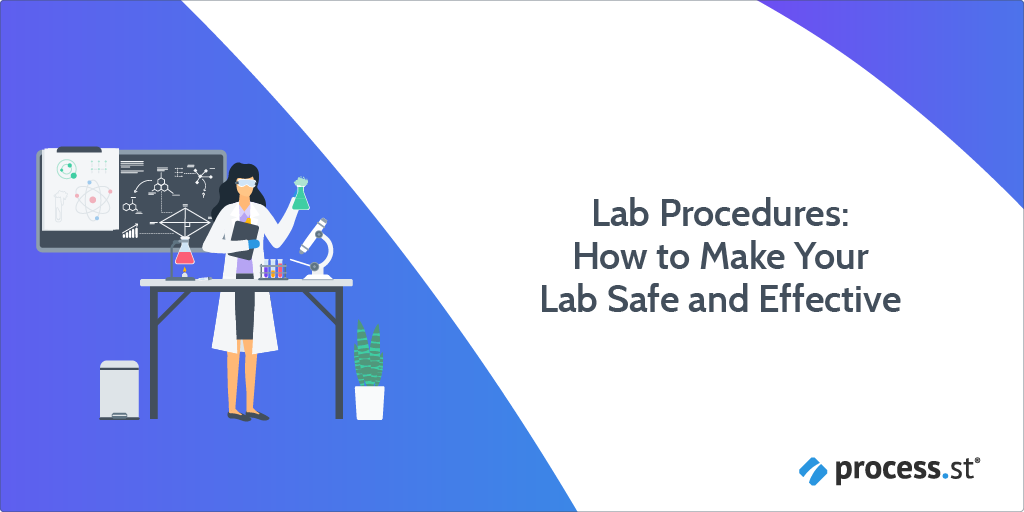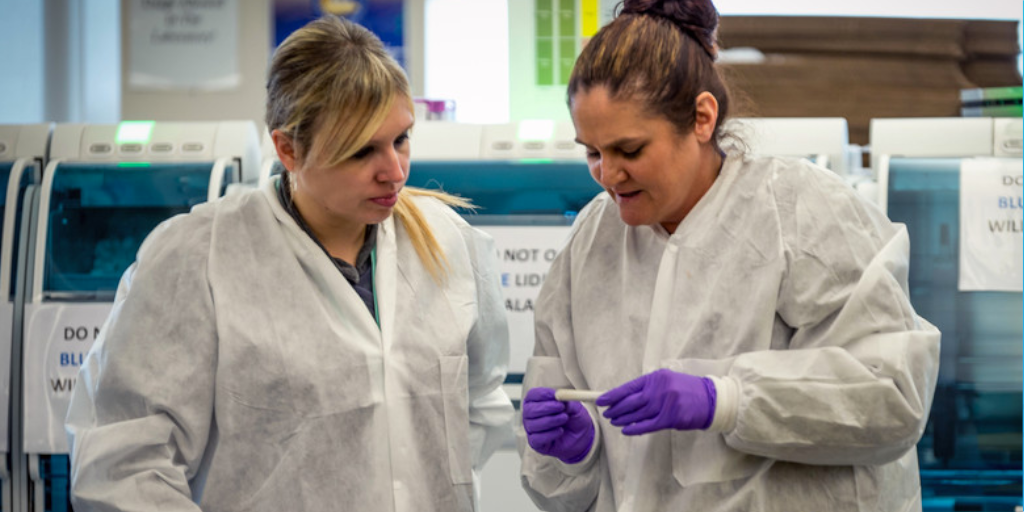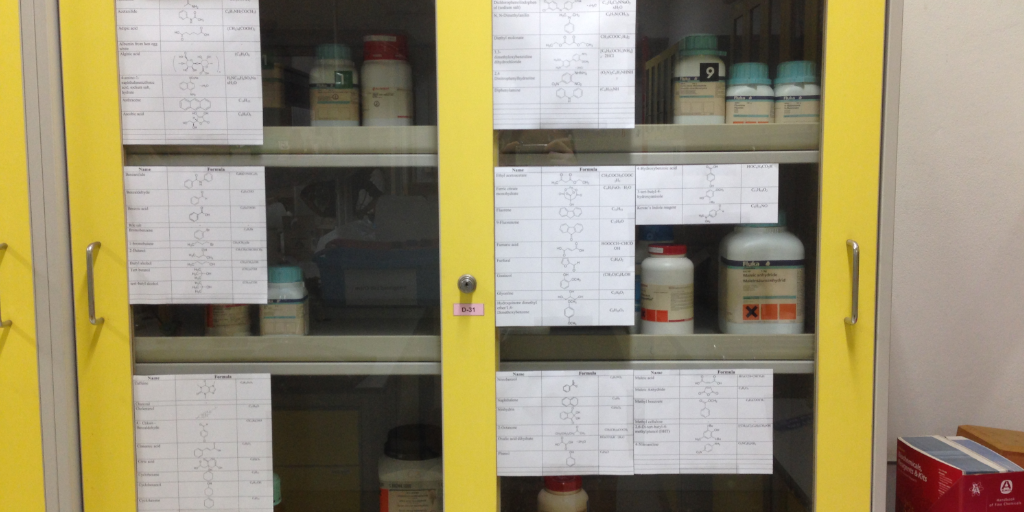
I’m not religious, but God bless high school lab technicians.
I can’t count the number of times that Dave (our high school’s technician), exasperated and exhausted, despaired at the lack of common sense some of our teachers had.
Heck, our physics teacher once almost exposed a classroom of Year 7s (11 years old!) to chlorine gas.
He forgot to turn on the extractor fans, leaving poor old Dave to rush in, turn them on, and then promptly evacuate everyone from the room.
Corroding the lungs of your students is, after all, not best practice.
This is why it’s important to have set lab procedures in place. Following these documented processes is the best way to prevent disaster.
When 25-38% of lab personnel have been in an accident that wasn’t even reported (as demonstrated by Dana Ménard and John Trant), you can see the dangers that are easily taken for granted in a lab environment.
That’s why we here at Process Street have created a Lab SOP process that you can use for free, and will go over the common points that a lab procedure needs to cover in this post.
If you just want to get the checklist for yourself, you can check it out below.
You can also click the links below to be taken to a specific section of the article:
- What are lab procedures?
- Why lab procedures are important
- Common lab procedure touchpoints
- Get started with our Lab SOP template
- Document and track your procedures with Process Street
What are lab procedures?
Lab procedures are detailed documents, checklists or guidelines that instruct you how to safely carry out an action in a laboratory environment.
The key here is to remember that a lab process tells your team how to do something (create a compound, carry out a reaction, etc). A lab procedure gives you the specific instructions of a certain action in great detail.
Processes and procedures can often be confused, as a certain level of perspective is needed when telling them apart. Most procedures can be considered processes but not all processes can be called procedures due to the level of detail in them, or because they take a high-level approach to the situation.
If that all sounds too complicated, think of it this way.
Lab procedures are sets of instructions you can follow to correctly, consistently, and effectively carry out a specific action every time it’s required.
Why lab procedures are important
You don’t need me to tell you that the chemicals you work with in a lab can be extremely dangerous.
But I’m going to anyway. Time for another anecdote!
One of my friends from high school was (and still is) a chemistry nut. A precursor to his current job in a lab, in school he used to order chemicals for his own home experiments and became well-known by the teachers and lab assistants.
One day, he was then told a story by Dave (the tech who saved a classroom from our physics teacher).
Dave used to work in a lab where one of the team loved sour sweets. He loved sour sweets so much that he used to dip his supply in citric acid from the lab to give it an extra kick.
Then, one day, when he was working early, he grabbed the wrong chemical to lace his taste buds.
Turns out TNT was a little much for his mouth (and head) to handle.

Now, since gaining more experience, my friend has assured me that this story is probably just a cautionary tale. Actually, his precise words were; “TNT isn’t so sensitive. But nitroglycerine is!”
We’re in safe hands.
No matter what you believe about the viability of TNT as an extreme form of popping candy, nobody can argue that lab work can be taken lightly.
If procedures aren’t up to scratch and followed to the letter, there’s every chance that something can go wrong. This is especially true when digitalising workflows – you have to navigate documenting the procedure while also adapting to a digital format.
Depending on what you’re working with, the results of this negligence can range from supplies being stored incorrectly and becoming unusable to the entire facility going up in smoke.
Common lab procedure touchpoints
The trouble with trying to create an all-encompassing “lab procedure” is that everything that you need to do will depend on the activity you’re trying to perform.
Different chemicals need to be handled in specific ways, certain reactions require specialist equipment, and so on. The trick is knowing what procedure to follow for each occasion.
Not only that, but you need to leave room for process improvement and iteration. You can’t have a static process and expect it to be relevant for long.
That being said, we wouldn’t be Process Street if we left it at that, so here are some pointers on what you should include at a minimum:
- Decide which procedure you’re documenting
- Identify roles and responsibilities
- Detail what can go wrong
- Have a clear method for monitoring and auditing
- Set guidelines for handling materials
- Always be aware of storage conditions
- Link to or provide more specific processes
Lab procedures touchpoint 1: Decide which procedure you’re documenting
Kick things off by deciding which procedure you’re going to document first.
No, this isn’t a trick question.
Trying to record your entire system’s operations in one go is a recipe for disaster, with missed details and vague instructions.
Instead, take the time to dedicate each procedure to a single activity (creating type X chemical, testing type Y reaction) and provide a set scope (start and end) for the event. Take care to note project constraints, methods, and so on.
Lab procedures touchpoint 2: Identify roles and responsibilities

Next, you need to identify the people involved and lay out the accountability of each activity and item.
That doesn’t mean that you have to label every bunsen burner and give a full inventory at the beginning of every procedure before you start your tasks.
However, everyone who’s involved in the procedure needs to know what they have to do, what they’re responsible for, and who they’ll be working with.
Lab procedures touchpoint 3: Detail what can go wrong
It’s vital to identify what can potentially go wrong during the procedure. Think of it as planning for the worst-case scenario.
It would be much easier to get on with your work and put faith in your safety, security, and auditing procedures to check your equipment before you use it. Unfortunately, this is a recipe for disaster and complacency.
Identifying risks and hazards is also a great way to pick out what safety equipment your team will need to carry out the procedure you’re recording.
Lab procedures touchpoint 4: Have a clear method for monitoring and auditing
Next, you need to have a clear method for monitoring and auditing your procedures.
This is a common element to any good system of processes – there needs to be a way to know whether your team is following procedure. It’s no good having the best lab procedure in the world if your team isn’t following it.
I’ll go into more detail on this later but Process Street lets you do this effortlessly.
By documenting your procedures in Process Street and running single-use checklists from them, you can track who has been completing tasks and how often they’ve run the process at a glance of our dashboard.
Lab procedures touchpoint 5: Set guidelines for handling materials
No matter what kind of lab you’re working in, it’s safe to say that the things you’re handling need to be treated with respect for the sake of safety. That’s why you need to document these guidelines in your procedure.
This is an element that will largely depend on the procedure you’re writing and the items your procedure involves.
For example, certain chemicals may need protective gear to be worn or to be handled with certain equipment to prevent a reaction.
Lab procedures touchpoint 6: Always be aware of storage conditions

As a follow-up to handling guidelines, you also need to document how your items need to be stored. This includes any specialist equipment required, temperature guidelines (if applicable), and so on.
It’s also a good idea to use this opportunity to enforce your inventory storage guidelines.
For example, you could state that an item needs to be stored in a glass container at a particular temperature. Alone this is fine but it would be even more useful to give guidance on how to label the item to make sure that everyone knows what the container holds, and even where similar items are stored to prevent confusion.
Lab procedures touchpoint 7: Link to or provide more specific processes
It’s incredibly rare for a procedure to be completely separate from other processes. After all, if you’re focusing on a single procedure you’re not going to be able to cover every relevant topic.
That’s why you need to also document the related procedures and link to (or provide instructions on where to find) them.
Get started with our Lab SOP template
To get you started with your lab procedures, we here at Process Street have created this free Lab SOP template.
You can use this template as a base to create your own lab procedures with a consistent format and attention to detail. Alternatively, you can edit the template to suit your needs more directly.
Don’t leave anything up to chance. Click here to get the free Lab SOP template!
Document and track your procedures with Process Street
It’s time to stop leaving the success of your processes and experiments up to chance. It’s time to start using Process Street and to create a process for everything to ensure success.
Process Street is a state-of-the-art piece of business process management software that lets you document, track, and assign your standard operating procedures to ensure that tasks are carried out correctly every time.
Worried that someone will forget to store your chemicals correctly? Concerned that newer team members will make mistakes and waste resources?
Give them a process template to follow and those worries will become a thing of the past.
Check out the webinar below for a more thorough overview of Process Street’s workflow software.
If that’s not enough, take a look through our help site to see just how powerful our features are and how to create processes with ease.
Sound good? Then click here to get started with your free trial of Process Street!
Or see here for how Process Street can be your standard operating procedure software or onboarding software.
What do you use to manage your lab procedures? Do you have any wild stories of experiments gone wrong of your own? Let us know in the comments below!







 Workflows
Workflows Forms
Forms Data Sets
Data Sets Pages
Pages Process AI
Process AI Automations
Automations Analytics
Analytics Apps
Apps Integrations
Integrations
 Property management
Property management
 Human resources
Human resources
 Customer management
Customer management
 Information technology
Information technology



Ben Mulholland
Ben Mulholland is an Editor at Process Street, and winds down with a casual article or two on Mulholland Writing. Find him on Twitter here.